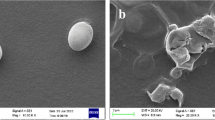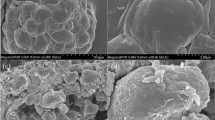Abstract
Radioactive liquid wastes contaminated by U are generated by solvent extraction of nuclear fuel materials in experiments of reprocessing technologies. We are focusing on baker's yeasts for their excellent metal ions adsorption characteristics, easy handling, and reasonable. We considered that chemically stable uranium oxides could be obtained by thermal decomposition of baker's yeast adsorbed with U, and investigated the waste liquid treatment process using baker's yeast. To clarify the adsorption mechanism, this study analyzed baker's yeast adsorbed with a simulant of the U. Uranium adsorption test was conducted to evaluate adsorption performance and identify issues in engineering-scale liquid waste treatment.






Similar content being viewed by others
Data availability
The datasets generated and/or analyzed during the current study are not publicly available due to contracts with analytical laboratories but are available from the corresponding author on reasonable request.
References
Watanabe S, Ogi H, Arai Y, Aihara H, Takahatake Y, Shibata A, Nomura K, Kamiya Y, Asanuma N, Matsuura H, Kubota T, Seko N, Arai T, Moriguchi T (2019) STRAD project for systematic treatments of radioactive liquid wastes generated in nuclear facilities. Prog Nucl Energy 117:103090
Arai Y, Watanabe S, Kubota T, Nomura K (2018) Radioactive nuclides recovery from spent solvent in STRAD project (1) Zr recovered by alkaline solutions. In: Proc DEM 2018—dismantling challenges: industrial reality, prospects and feedback experience, Avignon, France, 22–24, Paper 206
Nakamura F, Abe R, Arai T, Seko N, Hoshina H, Arai Y, Watanabe S, Nomura K (2018) Radioactive nuclides recovery from spent solvent in STRAD project (2) Zr adsorption onto ion exchange resins. IN: Proc DEM 2018—dismantling challenges: industrial reality, prospects and feedback experience, Avignon, France, 22–24, Paper 206
Arai Y, Watanabe S, Ohno S, Nomura K, Nakamura F, Arai T, Seko N, Hoshina H, Hagura N, Kubota T (2020) Microscopic analyses on Zr adsorbed IDA chelating resin by PIXE and EXAFS. Nucl Instrum Methods Phys Res B 477:54–59
Arai Y, Watanabe S, Ohno S, Shibata A, Nakamura F, Arai T, Seko N, Hoshina H, Hagura N, Kubota T (2019) Analysis on adsorbent for spent solvent treatment by micro-PIXE and EXAFS, IJPIXE. Int J PIXE 29:17–31
Nakahara M, Watanabe S, Aihara H, Takahatake Y, Arai Y, Ogi H, Nakamura M, Shibata A, Nomura K (2022) Harmless treatment of radioactive liquid wastes for safe storage in the systematic treatment of radioactive liquid waste for decommissioning project. Proc Global 2022:6–8
Saitoh N, Fujimori R, Nakatani M, Yoshihara D, Nomura T, Konishi Y (2018) Microbial recovery of gold from neutral and acidic solutions by the baker’s yeast Saccharomyces cerevisiae. Hydrometallurgy 181:29–34
Saitoh N, Fujimori R, Yoshimura T, Tanaka H, Kondoh A, Nomura T, Konishi Y (2020) Microbial recovery of palladium by baker’s yeast through bioreductive deposition and biosorption. Hydrometallurgy 196:105413
Leggett JE, Olsen RA, Spangler BD (1962) Cation absorption by baker’s yeast as a passive process. Biochemistry 48:1949–1956
Göksungur Y, Üren S, Güvenç U (2005) Biosorption of cadmium and lead ions by ethanol treated waste baker’s yeast biomass. Biores Technol 96(1):103–109
Padmavathy V (2008) Biosorption of nickel(II) ions by baker’s yeast: Kinetic, thermodynamic and desorption studies. Biores Technol 99(8):3100–3109
Arunraj B, Talasila S, Rajesh V, Rajesh N (2019) Removal of Europium from aqueous solution using Saccharomyces cerevisiae immobilized in glutaraldehyde cross-linked chitosan. Sep Sci Technol 54:1620–1631
Wang JL, Chen C (2006) Biosorption of heavy metals by Saccharomyces cerevisiae: a review. Biotechnol Adv 24:427–451
Liu M, Dong F, Zhang W, Nie X, Wei H, Sun S, Zhong X, Liu Y, Wang D (2017) Contribution of surface functional groups and interface interaction to biosorption of strontium ions by Saccharomyces cerevisiae under culture conditions. RSC Adv 7:50880–50888
Stathatou PM, Athanasiou CE, Tsezos M, Goss JW, Blackburn LC, Tourlomousis F, Mershin A, Brian WS, Nitin PP, Eric MD, Gao H, Gershenfeld N (2022) Lead removal at trace concentrations from water by inactive yeast cells. Commun Earth Environ 3:132
Kambe-Honjoh H, Ohsumi K, Shimoi H, Nakajima H, Kitamoto K (2000) Molecular breeding of yeast with higher metal-adsorption capacity by expression of histidine-repeat insertion in the protein anchored to the cell wall. J Gen Appl Microbiol 46(3):113–117
Sato Y, Valenzuela F, Tsuneyuki T, Kondo K, Nakashio F (1987) Extraction equilibrium of molybdenum(VI) with 2-ethylhexyl phosphonic acid mono-2-ethylhexyl ester. J Chem Eng Jpn 20:317
Hagura N, Kashimata K, Mochiki K, Oguri Y (2018) PIXE analysis of concrete composition in a research reactor facility under decommissioning. Int J PIXE 28(3&4):77–84
Hagura N, Hayashizaki T, Uchiyama T, Oguri Y, Fukuda H, Kawasaki K, Toriyama T, Mochiki K, Okada Y, Kawarabayashi J, Mitsuhashi I, Matsuura H (2018) Construction of 1.7 MV pelletron tandem accelerator system and its application to human resource development at Tokyo City University Atomic Energy Research Laboratory. Atomic Energy Soc Jpn 17(3–4):111–117
Ressler T (1998) WinXAS; a program for X-ray absorption spectroscopy data analysis under MS-windows. J Shynchrotron Rad 5:118–122
Li Z, Gao L, Zheng S (2003) SEM, XPS, and FTIR studies of MoO3 dispersion on mesoporous silicate MCM-41 by calcination. Mater Lett 57:4605–4610
Weber Th, Muijsers JC, van Wolput JHMC, Verhagen CPJ, Niemantsverdriet JW (1996) Basic reaction steps in the sulfidation of crystalline MoO3 to MoS2, as studied by X-ray photoelectron and infrared emission spectroscopy. J Phys Chem 100:14144–14150
Gowtham B, Ponnuswamy V, Pradeesh CGJ, Aradhana D (2018) MoO3 overview: hexagonal plate-like MoO3 nanoparticles prepared by precipitation method. J Mater Sci Mater Electron 29:6835–6843
Szende T, Boldizsár N, Anamaria T, Cerasella I, Cornelia M (2015) Cd(II), Zn(II) and Cu(II) bioadsorption on chemically treated waste brewery yeast biomass: the role of functional groups. Acta Chim Slov 62:736–774
Acknowledgements
EXAFS measurements were carried out under the proposal of 2018G573 of the Photon Factory, KEK, Japan. XPS measurements were carried out with the cooperation of the Sector of Fukushima Research and Development, Japan Atomic Energy Agency, Miharu-town, Fukushima, Japan.
Author information
Authors and Affiliations
Corresponding author
Ethics declarations
Conflict of interest
We do not have any conflict of interest in reviewing our paper entitled “Investigation of the applicability of baker's yeast to the uranium liquid waste treatment process” that is submitted to your esteemed journal for publication.
Additional information
Publisher's Note
Springer Nature remains neutral with regard to jurisdictional claims in published maps and institutional affiliations.
Rights and permissions
Springer Nature or its licensor (e.g. a society or other partner) holds exclusive rights to this article under a publishing agreement with the author(s) or other rightsholder(s); author self-archiving of the accepted manuscript version of this article is solely governed by the terms of such publishing agreement and applicable law.
About this article
Cite this article
Arai, Y., Hasegawa, K., Watanabe, S. et al. Investigation of adsorption mechanism of Mo(VI) by baker's yeast and applicability to the uranium liquid waste treatment process. J Radioanal Nucl Chem (2023). https://doi.org/10.1007/s10967-023-09278-5
Received:
Accepted:
Published:
DOI: https://doi.org/10.1007/s10967-023-09278-5




